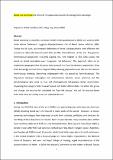Files in this item
Blood, sex and trust: : The limits of the population-based risk management paradigm
Item metadata
| dc.contributor.author | Kesby, Mike | |
| dc.contributor.author | Sothern, Matthew Barry | |
| dc.date.accessioned | 2016-03-21T11:00:05Z | |
| dc.date.available | 2016-03-21T11:00:05Z | |
| dc.date.issued | 2014-03-01 | |
| dc.identifier | 50356374 | |
| dc.identifier | 6910e203-6b1d-4782-96b4-061e8e404a11 | |
| dc.identifier | 84890834002 | |
| dc.identifier | 000331721700004 | |
| dc.identifier.citation | Kesby , M & Sothern , M B 2014 , ' Blood, sex and trust: The limits of the population-based risk management paradigm ' , Health & Place , vol. 26 , no. 1 , pp. 21-30 . https://doi.org/10.1016/j.healthplace.2013.11.004 | en |
| dc.identifier.issn | 1353-8292 | |
| dc.identifier.other | ORCID: /0000-0001-7789-870X/work/60195440 | |
| dc.identifier.uri | https://hdl.handle.net/10023/8447 | |
| dc.description.abstract | Blood screening is imperfect so Donor Health Check questionnaires (DHC) are used to defer those whose ‘behaviour’ suggests disproportionate risk of Blood Borne Infection (BBI). Taking the UK case, we compare deferment of three sub-populations with different HIV prevalence; Men-who-have-Sex-with-Men (4.7%), black-Africans (3.7%) and ‘the-general-(heterosexual)-population’ (c.0.09%) arguing that, with respect to STIs, DHC assesses risk based on broad population-level risk-groups not behaviour. This approach relies on an imaginative geography that distances heterosexual risk from the domestic population. Most DHCs knowingly commit the ecological fallacy allowing population-level statistics to obscure within-group diversity, inadequately identifying the risk posed by ‘low-risk-groups’. The disjuncture between ontological risk phenomenon (diverse sexual practice) and the epistemological grid used to map risk (homogenised risk-groups) needs examination. Unpacking the category ‘heterosexual’ would both better differentiate risk within this group and change the relative-risk calculated for ‘high-risk groups’. We call for piloting of practice-based questions and a mixed-method approach to DHCs to more accurately assess all potential donors. | |
| dc.format.extent | 9 | |
| dc.format.extent | 353540 | |
| dc.language.iso | eng | |
| dc.relation.ispartof | Health & Place | en |
| dc.subject | Blood donation | en |
| dc.subject | HIV | en |
| dc.subject | Risk-group | en |
| dc.subject | Trust | en |
| dc.subject | MSM | en |
| dc.subject | GF Human ecology. Anthropogeography | en |
| dc.subject | RA0421 Public health. Hygiene. Preventive Medicine | en |
| dc.subject | BDC | en |
| dc.subject | R2C | en |
| dc.subject | SDG 3 - Good Health and Well-being | en |
| dc.subject.lcc | GF | en |
| dc.subject.lcc | RA0421 | en |
| dc.title | Blood, sex and trust: : The limits of the population-based risk management paradigm | en |
| dc.type | Journal article | en |
| dc.contributor.institution | University of St Andrews. Geography & Sustainable Development | en |
| dc.contributor.institution | University of St Andrews. School of Geography and Geosciences | en |
| dc.identifier.doi | 10.1016/j.healthplace.2013.11.004 | |
| dc.description.status | Peer reviewed | en |
| dc.identifier.url | http://www.sciencedirect.com/science/article/pii/S1353829213001548 | en |
This item appears in the following Collection(s)
Items in the St Andrews Research Repository are protected by copyright, with all rights reserved, unless otherwise indicated.

